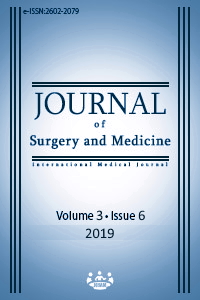Impact of morphological measurements on symptoms in Chiari malformation type 1
Keywords:
Chiari I malformation, Magnetic resonance imaging, Posterior cranial fossa, Tonsillar herniationAbstract
Aim: Chiari malformation Type 1 (CM1) is a pathology resulting from herniation of cerebellar tonsils or tonsils into the spinal canal. We aimed to examine the impact of the cranium’s morphological measurements on the symptoms with CM1 patients.
Methods: This research was designed as a retrospective case-control study in a single-center. 2309 patients aged between 18-70 who underwent brain magnetic resonance imaging (MRI) to confirm or exclude the diagnosis of CM1 as a result of clinical and examination findings were evaluated. Cranium’s morphological measurements, the amount of herniation, patient’s symptoms, and the modified Asgari score were retrospectively assessed.
Results: Patients with a final diagnosis of CM1 after the MRI evaluation were classified as study group (n=212), and the others control group (n=2097). The maximum cranial length, maximum cranial height, supra occiput length, posterior cranial fossa (PCF) anteroposterior length, in the study group were shorter, whereas the sagittal diameter of the foramen magnum and the longest anteroposterior diameter of the cerebrum were longer (P<0.001 for all mentioned comparisons). Tentorium cerebelli slope was found to be significantly lower in the study group (P<0.001). The most prevalent symptoms were a headache (92%). The herniation amount had a negative correlation with maximum cranial length and maximum cranial height (r=-0.184, P=0.07; r=-0.158 and P=0.022, respectively) and a positive correlation with the modified Asgari score (r=0.598; P<0.001).
Conclusion: The cranium’s morphological measurements have an impact on the symptoms of patients with CM1.
Downloads
References
Fernández AA, Guerrero AI, Martínez MI, Vázquez ME, Fernández JB, Chesa I Octavio E, et al. Malformations of the craniocervical junction (Chiari type I and syringomyelia:classification, diagnosis and treatment). BMC Musculoskelet Disord. 2009 Dec 17;10 Suppl 1:S1. doi: 10.1186/1471-2474-10-S1-S1.
Godzik J, Kelly MP, Radmanesh A, Kim D, Holekamp TF, Smyth MD, et al. Relationship of syrinx size and tonsillar descent to spinal deformity in Chiari malformation type I with associated syringomyelia. J Neurosurg Pediatr. 2014;13(4):368–74. doi: 10.3171/2014.1.PEDS13105.
Aiken AH, Hoots JA, Saindane AM, Hudgins PA. Incidence of cerebellar tonsillar ectopia in idiopathic intracranial hypertension: a mimic of the Chiari I malformation. AJNR Am J Neuroradiol. 2012;33(10):1901–6. doi: 10.3174/ajnr.A3068.
Barkovich AJ, Wippold FJ, Sherman JL, Citrin CM. Significance of cerebellar tonsillar position on MR. AJNR Am J Neuroradiol 1986;7(5):795–9.
Abbott D, Brockmeyer D, Neklason DW, Teerlink C, Cannon-Albright LA. Population-based description of familial clustering of Chiari malformation Type I. J Neurosurg. 2018; 128:460-5. doi: 10.3171/2016.9.JNS161274.
Poretti A, Ashmawy R, Garzon-Muvdi T, Jallo GI, Huisman TA, Raybaud C: Chiari Type 1 Deformity in Children: Pathogenetic, Clinical, Neuroimaging, and Management Aspects. Neuropediatrics. 2016;47(5):293-307. doi: 10.1055/s-0036-1584563.
Rogers JM, Savage G, Stoodley MA. A Systematic Review of Cognition in Chiari I Malformation. Neuropsychol Rev. 2018;28(2):176-87. doi: 10.1007/s11065-018-9368-6.
Fischbein R, Saling JR, Marty P, Kropp D, Meeker J, Amerine J, et al. Patient-reported Chiari malformation type I symptoms and diagnostic experiences: a report from the national Conquer Chiari Patient Registry database. Neurological Sci. 2015;36(9):1617-24. doi: 10.1007/s10072-015-2219-9.
Eppelheimer MS, Houston JR, Bapuraj JR, Labuda R, Loth DM, Braun AM, et al. A Retrospective 2D Morphometric Analysis of Adult Female Chiari Type I Patients with Commonly Reported and Related Conditions. Front Neuroanat 2018;12:2. doi: 10.3389/fnana.2018.00002.
McVige JW, Leonardo J. Neuroimaging and the clinical manifestations of Chiari Malformation Type I (CMI). Curr Pain Headache Rep. 2015;19(16):18. doi: 10.1007/s11916-015-0491-2.
Houston JR, Eppelheimer MS, Pahlavian SH, Biswas D, Urbizu A, Martin BA, et al. A morphometric assessment of type I Chiari malformation above the McRae line: A retrospective case-control study in 302 adult female subjects. J Neuroradiol. 2018;45(1):23-31. doi: 10.1016/j.neurad.2017.06.006.
Milhorat TH, Chou MW, Trinidad EM, Kula RW, Mandell M, Wolpert C, et al. Chiari I malformation redefined:clinical and radiographic findings for 364 symptomatic patients. Neurosurgery. 1999;44(5):1005–17.
Sekula RF, Jannetta PJ, Casey KF, Marchan EM, Sekula LK, McCrady CS. Dimensions of the posterior fossa in patients symptomatic for Chiari I malformation but without cerebellar tonsillar descent. Cerebrospinal Fluid Res. 2005;18;2:11. doi: 10.1186/1743-8454-2-11.
Taştemur Y, Sabanciogullari V, Salk I, Sönmez M, Cimen M. The Relationship of the posterior cranial fossa, the cerebrum, and cerebellum morphometry with Tonsiller Herniation. Iran J Radiol.1 2017; 4:236-44. doi: 10.5812/iranjradiol.24436.
Arnautovic A, Splavski B, Boop FA, Arnautovic KI. Pediatric and adult Chiari malformation Type I surgical series 1965-2013: a review of demographics, operative treatment, and outcomes. J Neurosurg Pediatr. 2015;15(2):161-77. doi: 10.3171/2014.10.PEDS14295.
Lei ZW, Wu SQ, Zhang Z, Han Y, Wang JW, Li F, et al. Clinical Characteristics, Imaging Findings and Surgical Outcomes of Chiari Malformation Type I in Pediatric and Adult Patients. Curr Med Sci. 2018;38(2):289-95. doi: 10.1007/s11596-018-1877-2.
Alperin N, Loftus JR, Oliu CJ, Bagci AM, Lee SH, Ertl-Wagner B, et al. Imaging-Based Features of Headaches in Chiari Malformation Type I. Neurosurgery. 2015;77(1):96-103. doi: 10.1227/NEU.0000000000000740.
Yarbrough CK, Greenberg JK, Park TS. Clinical Outcome Measures in Chiari I Malformation. Neurosurgery clinics of North America. 2015;26(4):533-41. doi: 10.1016/j.nec.2015.06.008.
Biswas D, Eppelheimer MS, Houston JR, Ibrahimy A, Bapuraj JR, Labuda R, et al. Quantification of Cerebellar Crowding in Type I Chiari Malformation. Ann Biomed Eng. 2019; 47(3):731-43. doi: 10.1007/s10439-018-02175-z.
Gilmer HS, Xi M, Young SH. Surgical Decompression for Chiari Malformation Type I: An Age-Based Outcomes Study Based on the Chicago Chiari Outcome Scale. World Neurosurg. 2017;107:285-90. doi: 10.1016/j.wneu.2017.07.162.
Downloads
- 1919 2253
Published
Issue
Section
How to Cite
License
Copyright (c) 2019 Rasime Pelin Kavak, Meltem Özdemir, Mehmet Sorar
This work is licensed under a Creative Commons Attribution-NonCommercial-NoDerivatives 4.0 International License.
















